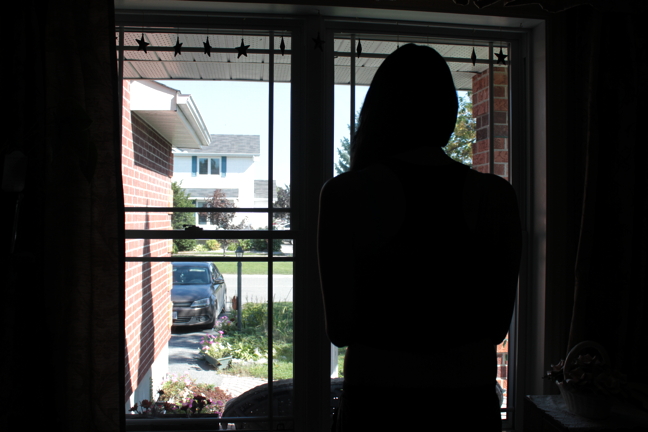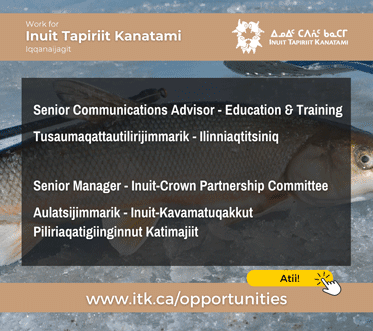Inuit foster kids fight to overcome trauma, abandonment: Part I in a series
“I feel like I wasn’t a kid. I was just a case number”

“I don’t feel like a human. I don’t feel like I ever had a chance to be a child,” says one young Inuk woman, and mother, who spent most of her life in foster and adoptive homes. (PHOTO BY LISA GREGOIRE)

Jennifer Switzer, Tungasuvvingat Inuit’s Youth in Transition worker — a position funded through the Ontario government — helps Inuit foster kids transition to independent adults in Ottawa. (PHOTO BY LISA GREGOIRE)
OTTAWA — When she was around 12, she tried to hang herself because it seemed like the only way to stop getting groped and raped by men and boys who came and went from the drunken household where she was raised.
A family member found her, cut her down and hugged her and though she didn’t trust anyone anymore, that hug felt good and she was grateful and she remembered that she had a younger sister to protect.
She is an adult now, 20 years old, brave and beautiful.
She likes horror movies and Eminem. She used to write stories and poetry but she suffers from anxiety now and can’t seem to pick up a pen anymore.
She’s trying to understand and dispel the nightmares and flashbacks, anger and fear and, perhaps hardest of all, the label of worthless which people placed on her until she believed them and called herself that too.
“It feels like a big hole, my memory — who I am, who I was,” she said.
“I feel like I wasn’t a kid. I was just a case number in the [Children’s Aid] Society. I don’t feel like a human. I don’t feel like I ever had a chance to be a child.”
This is what it’s like to be an Inuk foster child.
Because of the growing number of children in government care, inside and outside of Nunavut, Nunatsiaq News decided to track down some foster children, describe their experiences and then analyze the complicated systems in which they were raised.
It would be helpful to describe this young mom’s tattoos, tell you where she’s from and talk more about her family, but we are protecting her identity.
We can tell you she loves country foods and Inuit culture but is reluctant to attend Inuit events in Ottawa because someone might recognize her and want to talk about her mom or dad. She doesn’t talk about them.
But she remembers how her great-grandma made bannock and told stories in Inuktitut back home in Nunavut and how much she loved that lady for giving her moments of comfort and normalcy.
She has lived in more than a dozen foster homes from age seven onward, most of them in Ottawa. She doesn’t know exactly how many. She was even adopted a couple times. She never finished high school.
When she became an adult, she lived with a man and they had a baby but he had a messed up childhood too and turned out to be controlling and aggressive. Their baby was apprehended and put into foster care, continuing the discouraging cycle.
She tries and fails and tries again.
Here’s another story.
He was born to an Inuk mom outside of Inuit Nunangat. He is also 20 and spent his first two years of life in foster care with siblings.
His father eventually regained custody so he lived with his dad for a while but his dad was a drinker and home life was rarely safe or healthy.
His grandma went to residential school and his mom ended up on the streets of Ottawa. Drug addict. Sex trade worker. She’d show up periodically to get money from his dad.
He doesn’t really know his mom but says he doesn’t blame her for abandoning him. He says she had a bad life, was vulnerable, and made poor decisions.
At age 13, he was back in foster care and went through a series of homes before finding the right fit.
He was overweight in high school, using drugs and fighting. He ended up in youth detention a few times, angry and self-pitying and worried about his siblings with whom he’d lost touch. He played high school football. That helped.
At 18, he applied for and received transitional financial aid, got an apartment and enrolled in college. Then he met another foster kid and they fell in love.
They did a lot of drugs. He dropped out of school. Life quickly spiralled out of control again. He overdosed once and woke up in hospital.
The two broken kids eventually broke up and he got sober. He’s trying to get healthy again, find a job, maybe travel. He’s thinking of joining the military or the police academy.
“When I was getting arrested all the time, everyone was intimidated by the police officer. They gave them respect. I wanted that. I looked up to this figure,” he said.
“It was a constant thing in my life, dealing with police, with family or with my mom drunk and my dad calling the cops. In every situation, they took control. That’s something I wanted.”
The Ottawa-based Inuit community organization, Tungasuvvingat Inuit, which keeps an informal tally, knows of more than 250 Inuit kids who have had some contact with the Ottawa Children’s Aid Society in the past five years — temporary apprehension, short- and long-term foster care and adoption.
As of May 12, 2016, the Ottawa CAS had a total of 656 children in care, 65 of whom identified as First Nations and 35 Inuit.
Inuit youth represent fewer than 0.1 per cent of all youth in Ottawa but yet they comprise roughly six per cent of all children in care.
That’s just a point-in-time snapshot. It doesn’t tell you how many kids have already “aged-out” of the system, many of them just disappearing onto the streets of Ottawa and elsewhere after they turn 18. No one keeps track of them.
But TI is trying its best to reach out to those young adults before they fall though the cracks.
Jennifer Switzer runs the TI’s Youth In Transition program, a three-year pilot project funded through Ontario’s Ministry of Child and Youth Services and launched in 2014. The two young people interviewed for this story are part of that program.
That transition program funding emerged after a recommendation from Ontario’s child advocate who noted, after public hearings on child welfare in 2012, that one of the biggest problems with “the system” was the lack of transitional support for foster kids when they turn 18.
The TI program’s mandate is to help Inuit children, aged 16 to 24, who grew up in foster care, group homes or those whose adoptions have broken down, to become independent, functioning adults.
That means helping them go back to school, manage money, learn how to parent, get apartments and jobs, social insurance numbers, Inuit beneficiary cards and whatever else they need to be mentally and physically healthy.
Those are daunting tasks for youth with limited life skills. And the program is voluntary, and has to respect confidentiality rules, so Switzer can’t chase after youth and force them to participate.
But once engaged, Switzer can help her clients identify goals and devise a life plan. Then it’s up to them to keep appointments and put in the work.
Some youth, when they turn 18, prefer to just walk away, Switzer said.
They’re sick of being monitored and evaluated, shuffled from one social worker to another, telling their story over and over again. They want to be left alone and Switzer can’t blame them for that.
Another problem is overlapping jurisdictions.
Some of the Inuit youth in care here are wards of Ontario. Others are wards of Nunavut.
Nunavut youth who have been apprehended in Nunavut and, for whatever reason, can’t be housed and cared for at home, can end up in southern group homes and foster homes. But they are still wards of the Nunavut government and remain so, under territorial legislation, until age 26.
Up until very recently, those Nunavut wards were not eligible for Switzer’s program but now, as long as it’s listed as part of their care plan, Nunavut wards can participate.
But she doesn’t always know about those youth or how to find them.
The young Inuk mother we spoke to said she was lost before she started working with Switzer.
But she started seeing a doctor and got treatment for childhood trauma. When we last spoke, she was in a parenting group and trying to regain custody of her child.
“I didn’t know what I needed or wanted, how to get it. When Jenn and I met, she gave me an agenda and said, this is your Bible. Make a list of what to do, and step-by-step, we worked on stuff I never thought I could do on my own,” she said.
“She’s there to support me. She pushes me too. I’ve needed that for the longest time.”
As we went to press, we asked for an update on our young mother. While her living arrangements have changed again, she is still working to find peace and stability in her life.
The young man we spoke to just got a job. He’s piecing together his Inuit family tree and learning about siblings he never knew existed. He’s been volunteering and sitting on youth panels. He’s trying hard to be a responsible adult.
“I know I’m not ready but I have people who can help me get ready. It’s comforting to have those resources available,” he said.
“I don’t feel sorry for myself. I wouldn’t change anything that happened to me. I like who I am today. I didn’t like myself a few years ago but I do now.”
Come back to Nunatsiaq News Tuesday, May 24 for Part II in this series on Inuit children in government care: Who’s doing what to help them?





(0) Comments